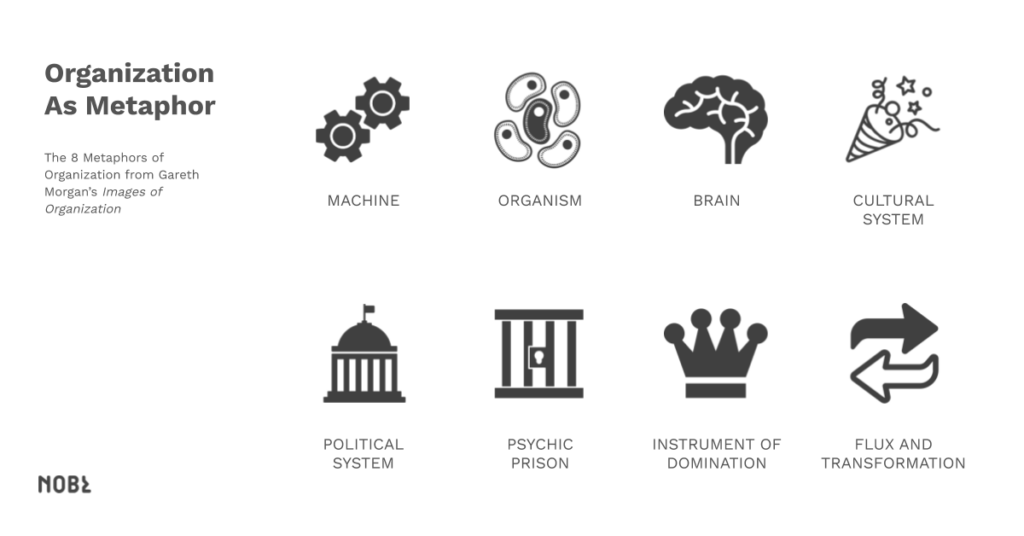Table of contents
When we start talking to teams during our Orient phase, we’re always listening for the organizational metaphors people use. Do they wish the team could act as a “well-oiled machine?” Maybe they describe their organization as “family”…. Or perhaps they compare promotions to surviving “The Hunger Games.”
The metaphors we use to describe our organizations speak volumes about our roles as leaders and our ability to make change to the culture. A good metaphor grabs attention and helps people see through a shared set of eyes. But metaphors can also be a trap: they can obstruct our perspective, and in turn, limit our understanding of a situation, and confine our choices.
Identifying and understanding the metaphors teams can give us clues about the barriers to change we might encounter, and how we can get people to work together in a new way.
The Eight Organizational Metaphors

In Images of Organization, Gareth Morgan lays out eight metaphors for an organization:
- Machine: an organization is a series of connected parts arranged in a logical order in order to produce a repeatable output
- Organism: an organization is a collective response to its environment and, to survive, must adapt as the environment changes
- Brain: an organization is a set of functions designed to process information and learn over time
- Cultural System: an organization is a mini-society, with its own culture and subcultures defined by their values, norms, beliefs, and rituals
- Political System: an organization is a game of gaining, influencing, and coordinating power
- Psychic Prison: an organization is a collection of myths and stories that restrict people’s thoughts, ideas, and actions
- Instrument of Domination: an organization is a means to impose one’s will on others and exploit resources for personal gains
- Flux and Transformation: an organization is an ever-changing system indivisible from its environment
Let’s take a closer look at each metaphor and what it means for leaders attempting to change the culture.
Organization as Machine
People who use the metaphor of “machine” want a profound sense of order and control. They strive for neatly partitioned roles and seek interchangeable people to fill those roles. Above all, they expect logic and reason to always win the day.
- When this metaphor works: In the same context as when machines do, i.e. when there is a straightforward task, a stable environment, a repeatable outcome, and a focus on precision.
- When this metaphor fails: When the environment changes, and when employees crave a greater sense of purpose and human agency.
- What this organizational metaphor means for leadership: Under this paradigm, leaders think and workers do; it’s the duty of a leader to lay out exact requirements for every role and swap people out when there is an under-performance.
- What this metaphor says about organizational change: People who hold this view think that change is a matter of shutting down, replacing a cog, and easily resuming production. Unfortunately, this overlooks how people actually think and feel about change.
Organization as Organism
People who see organizations as organisms are concerned with the environment surrounding the organization and how best to fit into that environment. Changes to that environment demand a response.
- When this metaphor works: When there is a clear and discrete change in the environment that threatens the organization’s survival (e.g., a new regulation is enacted).
- When this metaphor fails: When change is continuous and when uncertainty is rampant.
- What this organizational metaphor means for leadership: Under this paradigm, leaders are called to sense for discrete, predictable changes and formulate a step-by-step plan of action in response.
- What this metaphor says about organizational change: People who hold this view (and many traditional models of change management) believe you can make a change and then return to a state of normalcy. But if change is constant (as it often is in current markets) watch out: there can never be a return to “normal.”
Organization as Brain
People who see organizations as brains are concerned with the collective intelligence and organized wisdom of the organization. They see employees as sensors, and management layers as sense-making functions in the pursuit of developing a learning organization.
- When this metaphor works: When the environment is rife with unknowns but relatively stable, so that learnings are still relevant over time (e.g. a team of medical researchers hoping to cure cancer).
- When this metaphor fails: When change is so unprecedented that knowledge of the past is no longer helpful for predicting and responding to the future.
- What this organizational metaphor means for leadership: Under this paradigm, leaders are expected to install and instill the capacity for double-loop learning, helping teams not only develop feedback loops that help them gauge their effectiveness, but also feedback loops that help them question how they define effectiveness itself.
- What this metaphor says about organizational change: People who hold this view assume that past knowledge is always predictive of future behavior, meaning that changes can be rationalized and planned for with the benefit of enough hindsight and pattern recognition—which works in some, but not all, circumstances.
Organization as Cultural System
People who see organizations as cultural systems are concerned with the shared beliefs, norms, and rituals of an organization. They often think of the organization as a mini-society, and are interested in the holistic experience of being an employee of the organization.
- When this metaphor works: When competition for talent is fierce and employees desire for shared identity in their work.
- When this metaphor fails: When cultures become cult-like, i.e. when entering and exiting the culture causes trauma; when external changes are ignored in favor of group cohesion; or when a push for a homogenous culture drives out subcultures and drives away talent who are not deemed “culture fits.”
- What this organizational metaphor means for leadership: Under this paradigm, leaders are expected to be the embodiment of their cultures.
- What this metaphor says about organizational change: People who hold this view must recognize that cultural systems favor tradition and reject change. As a result, they struggle to assimilate changes, which feel like threats to their core values and beliefs.
Organization as Political System
People who see organizations as political systems are chiefly concerned with gaining and wielding power and influence. They view employees as followers to accrue, fellow leaders as either allies or foes, and superiors as those to influence and control.
- When this metaphor works: When there are diverse and conflicting interests and when self-interests overrule rationality.
- When this metaphor fails: When a competitor or change of any kind emerges as a threat so great that only the collective cooperation of the organization can face it.
- What this organizational metaphor means for leadership: Under this paradigm, leaders are expected to vie for attention, influence, and dominance; this can lead to a single-minded obsession with how leaders are perceived (i.e. how they perform in a meeting) even over their long-term performance.
- What this metaphor says about organizational change: People who hold this view assume that the leader who emerges victorious from a political system is one who can foresee and marshal change—and some politicking is always required in organizations. Alas, history is replete with examples of leaders who successfully manipulate political systems but fail to respond to societal shifts.
Organization as Psychic Prison
People who see organizations as a psychic prison want to broaden our ability to perceive, question, and change our organizations. They fear that their organizations are trapped in a static way of thinking, that they adopt conformist ideals, and overall resist change.
- When this metaphor works: When past success, societal norms, and unconscious biases have deluded the organization into a state of complacency and/or persistent discrimination.
- When this metaphor fails: When the need to embrace new ways of thinking overrides the commercial realities of the organization.
- What this organizational metaphor means for leadership: Under this paradigm, leaders are called to question their own self-awareness, prejudices, and biases in order to create more inclusive and equitable environments.
- What this metaphor says about organizational change: People who hold this view encourage organizations to progress ahead of governmental and societal changes. This is obviously challenging when an organization is large and diverse enough to encompass a broad set of views and opinions.
Organization as Instrument of Domination
People who see organizations as an instrument of domination are often terrible people to work with and for. They see employees as objects to be subjugated. They also tend to see the natural resources available to the company as theirs to exploit.
- When this metaphor works: In some cases, this is the most realistic view of organizational life (sadly).
- When this metaphor fails: This view can be adopted by activists who paint a miserable and myopic view of any kind of effort concentrated to a capitalist end.
- What this organizational metaphor means for leadership: Under this paradigm, leaders are expected to override the will and self-determination of their subordinates.
- What this metaphor says about organizational change: People who hold this view fail to respond to meaningful external change because it prioritizes the personal wants and needs of a leader—if a leader doesn’t find it attractive to change, the organization will not change.
Organization as Flux and Transformation
People who see organizations in terms of flux and transformation have embraced uncertainty, complexity, and even chaos in terms of the changes their organization is experiencing. You can think of this metaphor as an evolution of “Organism”–rather than thinking that simply the environment changes and then the organization must respond in kind, this metaphor says that both the environment and organization influence one another, and both must respond to change.
- When this metaphor works: When there is continuous and complex change; when cause and effect no longer have direct correlation.
- When this metaphor fails: When the organization itself needs only work as simply as a machine, or when the external chaos causes leaders to throw up their hands and abdicate responsibility for change.
- What this organizational metaphor means for leadership: Under this paradigm, leaders are called to experiment with small, safe-to-fail changes and then marshal resources to further successful experiments while shutting down failure. In contrast to the organism view, changes within an organization also spur changes in the environment
- What this metaphor says about organizational change: People who hold this view advocate for a test and learn mentality, even over rushing to introduce a series of planned changes informed by pattern recognition. While this is largely the case for process changes, some changes—like reorgs—simply can’t be approached this way.
How Leaders Can Use Organizational Metaphors
Organization always hinges on the creation of shared meanings and shared understandings, because there have to be common reference points if people are to shape and align their activities in an organized way. – Gareth Morgan
If you’re considering your own organizational transformation:
- Assess your organization’s environment. Are you going through a time of rapid, continuous change, or are things relatively static? What’s causing the need for change?
- Determine your “From–Tos.” What metaphor, or elements of the metaphor, most closely represent your organization today? And what should it look like in the future?
- Identify needed behaviors. Metaphors are a helpful tool to conceptualize organizations, but to make real change, you must influence behaviors. What must people do differently in order to achieve the desired future state?
We’ve created a Change Charter to help leaders capture and track these ideas—give it a try.













